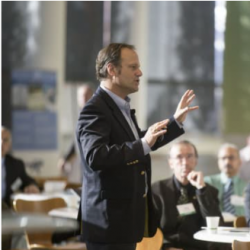Sunday, January 23, 2022

“The words you speak today should be soft and tender, for tomorrow you may have to eat them.” – unknown
Are you weary of being a speaker on Zoom, Teams, Google Meet, or a host of other virtual communication tools? I know I am.
We are not “out of the woods” with this virus yet, but have you planned on your transition to speaking before live audiences? If you haven’t, you are already behind.
Just like “Yes, Virginia, there is a Santa Claus,” “Yes speaker, there will be live in-person speaking for you in the not too distant future.” Are you ready?
This article presents three differences between virtual and in-person speaking you need to plan for when, not if, you will be speaking before a live audience.
Your Body Language
Your body language is responsible for the majority of your communication. Unfortunately, to seasoned speakers (You may be one), virtual communication platforms like Zoom are unbelievably restrictive for body language.
Remember the last time you spoke to an audience through a virtual communication platform. How much of your body could your audience see? They could see maybe from the middle of your chest and up. Upwards of three-quarters of your body could not be seen. You were probably doing all sorts of gestures that were not seen by your audience.
You were also probably sitting, which has its drawbacks. When you sit, you get relaxed. But, unfortunately, you may have relaxed too much. A relaxed speaker is a flat speaker.
For those of you that realized this, you made it a common practice to step away from your laptop so your audience could see at least three-quarters of your body which is a good practice.
practice your body language by recording yourself through your preferred virtual communication platform and objectively evaluating your performance.
So practicing the language of your entire body is undoubtedly essential. There is another difference between virtual and in-person speaking you need to be aware of and use to increase your engagement with your audience – your speaking aura
Your Speaking Aura
The best way to explain your speaking aura is through an example.
I am sure you have watched sporting events, concerts, and plays on TV. I am also certain you have attended these events in person. Which did you enjoy more. I am guessing, but I think you enjoyed the live event more. Why is this?
Here’s my theory. When you watch sporting events, concerts, and plays on TV, the dryer buzzer is going off, your wife or husband is talking to your daughter, or your son comes downstairs and tells you he needs help with his homework assignment. In other words, there are distractions when you witness an event on TV.
Also, even if your seats in the arena are at “nosebleed” level, the aura in the arena of seeing Neil Diamond, Gloria Estephan, or Celine Dion in concert is evident. You feel part of the songs they are singing.
Why am I explaining this? I explain this because when you speak before in an in-person, you are Neil Diamond, Gloria Estephan, or Celine Dion. So people in your audience feel your aura just like these superstars.
Your aura can significantly enhance your engagement with your audience, whether they remember your presentation for an hour, a week, or a year or beyond.
You can use your aura to reach the emotions of your audience. It was Maya Angelou who said, “I’ve learned that people will forget what you said, people will forget what you did, but people will never forget how you made them feel.”
Use your aura to the fullest!
So, your body language and aura are two differences between virtual and in-person speaking.
The third difference between virtual and in-person speaking is your lighting.
Your Lighting
Lighting may sound like a blah subject, but it can make all the difference in the world.
In the virtual world, it is easy. Have the light behind your laptop. You will look like a shadow in the witness protection program if you have a light behind you.
If you want an “A” score in lighting, have two lights spreading their light diagonally at you. This will take away any shadows on your face.
So, it is relatively easy to fix lighting when speaking virtually. However, it is “a whole other ballgame when you are live before an audience.”
You may not have control over the lighting in the event room. Therefore, it behooves you to visit the event room a day or two before your presentation. Ensure you have someone there to operate the lighting to show you how you would look at your actual presentation.
Some basic rules: You, as the speaker, should have lighting on you at all times. A spotlight from the back of the room is best. Lights from above can put a shadow on your face. You want your facial expressions to be seen also. They are part of your body language, and now you know body language is the majority of your communication.
Technically this is a fourth difference, but ensure the pickup level on your lapel mike is at the level where your audience can hear you, but your voice is not overpowering.
So, your body language, aura, and lighting are three differences between virtual and in-person speaking. Are there more differences? Yes, and maybe I will talk about them in a future article, but don’t sell yourself short. You have been before live audiences and before audiences virtually. So, “put on your thinking cap” and make a list of the differences and how your in-person speaking will be different than your virtual speaking.
If you don’t consider the differences between speaking virtually and in person, you will have a rude awakening when you get to talk in-person again.
Being forewarned is being forearmed!
Call to Action
Start practicing your whole body language for when you do speak in-person
Realize you have an aura when speaking in-person and use it to engage your audience more fully.
Lighting, lighting, lighting. Don’t underestimate the importance of lighting in your in-person speaking. Ensure the lighting in your speaking venue is such that you have no shadows on your complete body.
“Speech is power. Speech is to persuade, to convert, to compel. It is to bring another out of his bad sense into your good sense.”
– Ralph Waldo Emerson
_____________________________ Frank DiBartolomeo is a retired U.S. Air Force Lieutenant Colonel and award-winning speaker, presentation and interview skills coach, and Professional Member of the National Speakers Association. He was awarded Toastmasters International’s highest individual award, Distinguished Toastmaster because of his outstanding work in public speaking and leadership.
Frank formed DiBartolomeo Consulting International (DCI), LLC (www.speakleadandsucceed.com) in 2007. The mission of DCI is to help technical professionals to inspire, motivate, and influence their colleagues and other technical professionals through improving their presentation skills, communication, and personal presence. Frank can be reached at frank@speakleadandsucceed.com and (703) 509-4424.
Don’t miss Frank DiBartolomeo’s latest book!
“Speak Well and Prosper: Tips, Tools, and Techniques for Better Presentations”

Available now at Amazon.com and BarnesandNoble.com
“Speech is power. Speech is to persuade, to convert, to compel. It is to bring another out of his bad sense into your good sense.” – Ralph Waldo Emerson
_____________________________ Frank DiBartolomeo is a retired U.S. Air Force Lieutenant Colonel and award-winning speaker, presentation and interview skills coach, and Professional Member of the National Speakers Association. He was awarded Toastmasters International’s highest individual award, Distinguished Toastmaster because of his outstanding work in public speaking and leadership.
Frank formed DiBartolomeo Consulting International (DCI), LLC (www.speakleadandsucceed.com) in 2007. The mission of DCI is to help technical professionals to inspire, motivate, and influence their colleagues and other technical professionals through improving their presentation skills, communication, and personal presence. Frank can be reached at frank@speakleadandsucceed.com and (703) 509-4424.
Don’t miss Frank DiBartolomeo’s latest book!
“Speak Well and Prosper: Tips, Tools, and Techniques for Better Presentations”

Available now at Amazon.com and BarnesandNoble.com